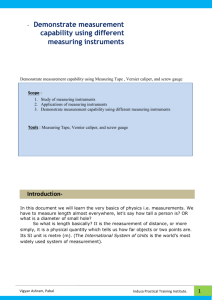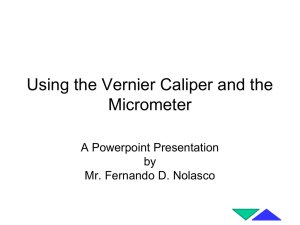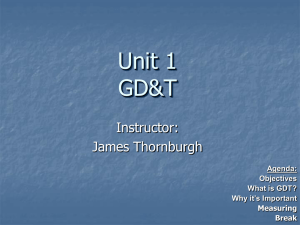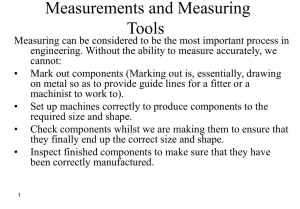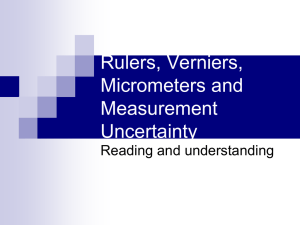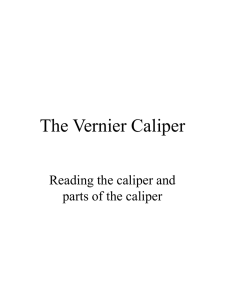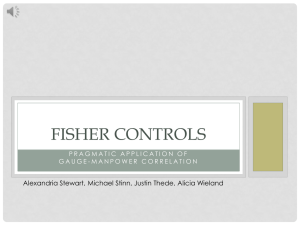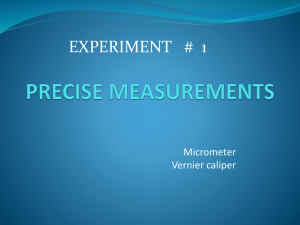Measurement Tools - Learning While Doing
advertisement
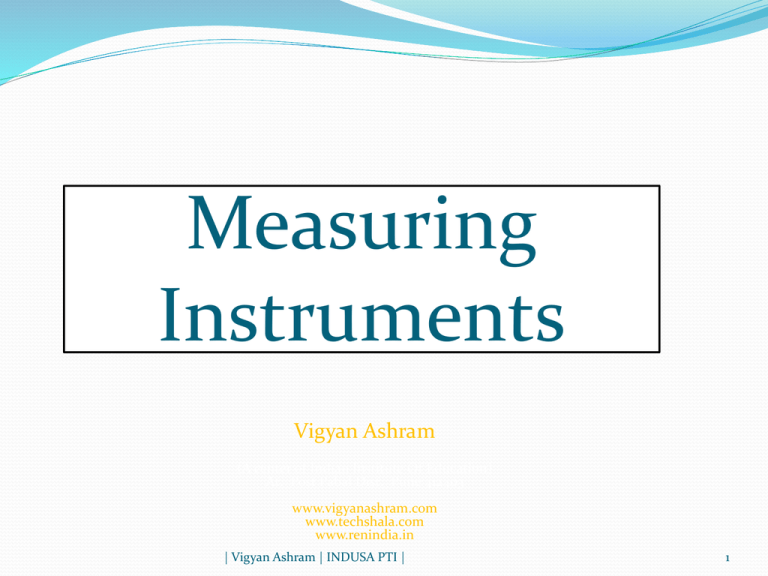
Measuring Instruments Vigyan Ashram (A center of Indian Institute Of Education) At. Post Pabal Dist. Pune 412403 www.vigyanashram.com www.techshala.com www.renindia.in | Vigyan Ashram | INDUSA PTI | 1 Measurement basics Measurement is an activity to compare a quantity with another quantity that is assigned as unit. Its SI unit is metre (m). (The International System of Units is the world's most widely used system of measurement) To measure the quantity of length, we can use a various instruments. Every instrument is designed for different precision and range Precision is the smallest unit (minimum length) an instrument can measure Range is the maximum length an instrument can measure | Vigyan Ashram | INDUSA PTI | 2 Measuring instruments Basically three instruments are used : 1. Measuring Tape 2. Vernier Caliper 3. Micrometer Screw Gauge | Vigyan Ashram | INDUSA PTI | 3 Measuring Tapes • Measuring tapes are basically rulers that are flexible in nature. • Mostly they are constructed of a thin band of metal or made with cloth. •Handy in nature so ideal for carrying or storing in small spaces. •Measuring Tape will typically use the same units of measurement that are common with rulers (The most common tape measures are 12 feet, 25 feet, or 100 feet in length) | Vigyan Ashram | INDUSA PTI | Measuring Tapes 4 Measuring Tapes Uses : They can be used in a number of different professions like carpentry , tailoring , construction...etc | Vigyan Ashram | INDUSA PTI | 5 Vernier Caliper The inside jaws shown are used to measure the internal diameters of objects while the outside jaws are to measure the external diameter. The vernier calipers have a main scale and a sliding vernier scale. Vernier Caliper can be used to measure diameter, thickness very accurately as it’s precision is 0.01 cm i.e. 0.1 mm. | Vigyan Ashram | INDUSA PTI | 7 Vernier Caliper Use the inside jaws of the caliper as shown | Vigyan Ashram | INDUSA PTI | 8 Vernier Caliper Use the outside jaws of the caliper as shown to measure external diameter | Vigyan Ashram | INDUSA PTI | 9 Vernier Caliper Use the depth gauge of the caliper as shown to measure depth of a hole | Vigyan Ashram | INDUSA PTI | 10 Reading the Vernier Scale 1. Read the “0” position of the vernier scale on the main scale to get a rough reading. Rough reading = 18mm 2. Look along the vernier scale until one of the vernier division coincides with the main scale Accurate reading = 18.46mm±0.01 mm | Vigyan Ashram | INDUSA PTI | 11 Precaution before measuring Precaution before measuring using Vernier caliper In a vernier caliper, you can either have a positive zero error or a negative zero error if the zero of the main scale does not coincide with the zero of the vernier scale. If the zero mark is slightly on the right side of the zero on the vernier we have a positive zero error. If it is on the left, then a negative zero error. To get the correct reading, the poistive zero error is subtracted from the final reading and the negative Z.E is added | Vigyan Ashram | INDUSA PTI | 12 Vernier Caliper Uses To measure depth gauge Measuring the centre distance between holes Internal and the external diameters of an object Vernier calipers are widely used in scientific laboratories and in manufacturing for quality control measurements | Vigyan Ashram | INDUSA PTI | 13 Micrometer Screw Gauge | Vigyan Ashram | INDUSA PTI | 14 Micrometer Screw Gauge Closer look of Sleeve and Thimble | Vigyan Ashram | INDUSA PTI | 15 Micrometer Screw Gauge It consists of a hollow cylinder mounted on a U frame. The U frame consists of a flat end known as stud and a screw on the other side. This screw can be moved inside the nut by fitted in the U frame by rotating the hollow cylinder called the thimble. This is called the main scale. The hollow cylinder or the thimble is graduated into 50 or 100 equal parts. This is called the circular scale. To measure smaller lengths, micrometer is used as it has an even smaller precision i.e. 0.001 cm or 0.01 mm. It’s range is less than 2 cm | Vigyan Ashram | INDUSA PTI | 16 Reading the Micrometer Screw Gauge • The object whose diameter is to be measured is placed between anvil and spindle • The reading of the main scale that coincides with the edge of the outer wrap is 7,5mm. • The outer wrap line which coincides exactly with the horizontal line of the main schale is 38-th line. Thus, the reading of the micrometer screw gauge is (7,5mm + 38 part) = 7,5mm + 0,38mm = 7,88mm. | Vigyan Ashram | INDUSA PTI | 17 Precaution before measuring Precaution before measuring using Micrometer Screw Gauge • When the anvil and spindle end are brought in contact, the edge of the circular scale should be at the zero of the sleeve (linear scale) and the zero of the circular scale should be opposite to the datum line of the sleeve. •If the zero is not coinciding with the datum line, there will be a positive or negative zero error as shown in figure | Vigyan Ashram | INDUSA PTI | 18 Micrometer Screw Gauge Uses Precision of Micrometer Screw Gauge is 0.001 cm or 0.01 mm. It’s range is less than 2 cm It is widely used in mechanical engineering and machining as well as most mechanical trades, along with other metrological instruments such as dial, vernier, and digital calipers Used for measuring accurately the diameter of a thin wire or the thickness of a sheet of metal. | Vigyan Ashram | INDUSA PTI | 19 Thanks For further information: Website : www.vigyanashram.com e-Mail : vapabal@gmail.com, director@vigyanashram.com
